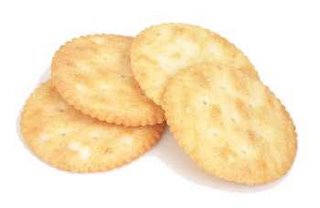 Today, November 21st …
Today, November 21st …A cracker, according to the OED, is a thin, hard biscuit. According to a lot of military men, it is a damn hard biscuit. The military version - “hardtack” - has been called by many names over many centuries by many soldiers and sailors - all of them descriptive, but none of them flattering. Aussie “Diggers” for example have referred to their ration biscuits as Stone Bread, Teeth Dullers, Sheet Iron, Flour Tile, Concrete macaroons, and Ammo (ammunition) Reserves. One particular Digger described them as having “the delicious succulency of ground granite or the savoury toothsomeness of powdered marble”.
Cracker biscuits had two important attributes in their military incarnation: their keepability and their absorbability. The former might have been more important to quartermasters and victuallers, but for soldiers, the absorbability of their biscuits served the dual purpose of avoiding broken teeth and making mealtime slop less sloppy (and hence the names “cracker hash” and “cracker stew”). This attribute has also been used by civilian cooks and housewives since at least the middle of the nineteenth century. By soaking up other standard flavourings, particularly in pies, they provided an illusion by association of the real thing – such as apples (the most common) or the meat in mincemeat pie, in this Canadian recipe from 1890.
Mock Mince Pie.
Three soda crackers rolled fine, one cup of cold water, one cup of molasses, one-half cup of brown sugar, one-half cup of sour cider or vinegar, one-half cup of melted butter, one half-cup of raisins, one half-cup of currants, one egg beaten light, one teaspoonful of cinnamon, one-quarter teaspoonful each of cloves, allspice and nutmeg, five apples chopped fine.
Cracker biscuits are not purely a military phenomenon of course, but there is an element of abstemiousness and virtue about them even in civilian society where they serve to make a bowl of soup look like a real meal, or to levitate a piece of cheese to the mouth in a polite way.
One day, something made someone in the Nabisco Company decide that the world needed a better cracker, one of less than military strength, and – to cut what was probably a longish story short – the Ritz Cracker was conceived. It was delivered on this day in 1934, with its name already decided by virtue of a competition. What a genius of a name! Four letters to overcome the connotations of hardship and hard texture and the dreariness of the Depression by associating the new biscuit with Cesar Ritz and his exclusive hotels!
This new improved cracker needed a new improved Mock Apple Pie of course, and a back-of-the-box recipe soon appeared which has become something of a cultural icon (although I am not sure which culture it belongs to), with its own cult following.
In case you should want to join the Mock Apple Pie cult, but are without a box handy, here is the recipe:
RITZ® Mock Apple Pie
Ingredients:
Pastry for 2-crust 9-inch pie
36 RITZ Crackers, coarsely broken (about 1-3/4 cups crumbs)
2 cups sugar
2 tsp. cream of tartar
Grated peel of 1 lemon
2 Tbsp. lemon juice
2 Tbsp. butter or margarine
1/2 tsp. ground cinnamon
Preparation:
PREHEAT oven to 425°F. Roll out half of the pastry and place in 9-inch pie plate. Place cracker crumbs in crust; set aside.
MIX sugar and cream of tartar in medium saucepan. Gradually stir in 1-3/4 cups water until well blended. Bring to boil on high heat. Reduce heat to low; simmer 15 minutes. Add lemon peel and juice; cool. Pour syrup over cracker crumbs. Dot with butter; sprinkle with cinnamon. Roll out remaining pastry; place over pie. Trim; seal and flute edges. Slit top crust to allow steam to escape.
BAKE 30 to 35 minutes or until crust is crisp and golden. Cool completely.
On this Topic …
On The Companion to The Old Foodie site you will find an article called:
"From Hardtack to Anzacs."
Tomorrow’s Story …
Musical Food (and Drink).
Quotation for the Day …
But when that smoking chowder came in, the mystery was delightfully explained. Oh! sweet friends, hearken to me. It was made of small juicy clams, scarcely bigger than hazel nuts, mixed with pounded ship biscuits and salted pork cut up into little flakes! the whole enriched with butter, and plentifully seasoned with pepper and salt.....we dispatched it with great expedition. Ishmael in Herman Melville's 'Moby Dick' (1851)
1 comment:
Looking for mock mincemeat pie made with " crackers " and your blog came up in the search field among common others but yours sounded the most familiar to one I made many , many years ago excluding the molasses ..but being the adventurous sort I think I will follow this one to the tee and hope it goes over . It sounds very rich ,spicy, and sweet . Thank you
Post a Comment